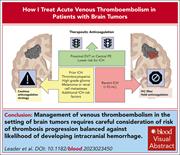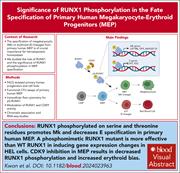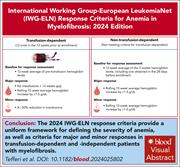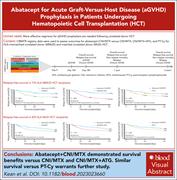Issue Archive
Table of Contents
BLOOD COMMENTARIES
PLENARY PAPER
Germ line ERG haploinsufficiency defines a new syndrome with cytopenia and hematological malignancy predisposition
In this Plenary Paper, Zerella and colleagues describe a novel bone marrow failure syndrome associated with a tendency to hematological malignancy (HM), reflecting a germ line haploinsufficiency of ETS-related gene (ERG). ERG is a transcription factor that is known to be critical for hematopoiesis. Initially identified in 3 family members with inherited thrombocytopenia, a large international collaboration yielded 14 other unrelated individuals with diverse ERG mutations. The pathophysiology underlying the surprising finding that the patients were also predisposed to HM remains to be further delineated.
HOW I TREAT
How I treat acute venous thromboembolism in patients with brain tumors
Venous thromboembolism (VTE) is common in patients with brain tumors, and management is challenging due to the risk of intracranial hemorrhage. Leader and colleagues discuss their approach to the management of acute VTE through 3 illustrative cases that highlight the need to balance hemorrhagic risk with the need for anticoagulation.
CLINICAL TRIALS AND OBSERVATIONS
Eltrombopag plus diacerein vs eltrombopag in patients with ITP: a multicenter, randomized, open-label phase 2 trial
Clinical Trials & Observations
Sun et al report results of a phase 2 trial of eltrombopag plus diacerein, an anthraquinone anti-inflammatory drug, vs eltrombopag alone in patients with immune thrombocytopenia (ITP) unresponsive to 14 days of eltrombopag treatment. Overall response rate (44% vs 12%, respectively) and duration of response were improved with the addition of diacerein, although both arms lost response over time. This suggests that the addition of diacerein may improve short-term responses for patients with ITP resistant to eltrombopag.
HEMATOPOIESIS AND STEM CELLS
CDK9 phosphorylates RUNX1 to promote megakaryocytic fate in megakaryocytic-erythroid progenitors
The megakaryocytic (Mk) and erythroid lineages arise from Mk-erythroid progenitors (MEPs), but the pathways that regulate lineage choice are not defined. RUNX1 is a key modulator of this cell fate decision, and Kwon et al demonstrate that overexpression of RUNX1 in primary human MEPs promotes Mk maturation. The authors show that cyclin dependent kinase 9 (CDK9) phosphorylation of RUNX1 modulated MEPs toward Mk differentiation, while CDK9 inhibition shifted them toward erythroid maturation.
MYELOID NEOPLASIA
Proposals for revised International Working Group–European LeukemiaNet criteria for anemia response in myelofibrosis
Brief Report
Emerging new drugs for myelofibrosis (MF) are difficult to compare because of the variable approach to defining anemia and response to therapy. Tefferi and other members of the International Working Group–European LeukemiaNet propose revised guidelines for anemia that account for gender-specific differences in hemoglobin levels, redefine transfusion-dependent anemia to account for current restrictive transfusion practices, and provide simple criteria that more accurately assess therapeutic response. These changes should allow for more uniform evaluation comparing interventions for MF-related anemia.
THROMBOSIS AND HEMOSTASIS
Coagulation factor XI regulates endothelial cell permeability and barrier function in vitro and in vivo
Factor XI (FXI) plays a role in inflammation and increases vascular permeability, but the details of its role in increased permeability is unclear. Puy et al report that activated FXI (FXIa) increases endothelial cell permeability, triggering events that induce cleavage of vascular endothelial (VE) cadherin, which maintains intracellular tight junctions. FXIa binds plasminogen activator inhibitor 1 and very low-density lipoprotein receptor, activating vascular endothelial growth factor receptor 2. This triggers mitogen-activated protein kinase signaling, which increases surface expression of a disintegrin and metalloproteinase 10, which cleaves VE-cadherin.
TRANSPLANTATION
Abatacept for acute graft-versus-host disease prophylaxis after unrelated donor hematopoietic cell transplantation
Clinical Trials & Observations
Kean et al report on a retrospective study comparing abatacept/calcineurin inhibitors/methotrexate (A/CNI/MTX) vs CNI/MTX, CNI/MTX plus antithymocyte globulin (ATG), and cyclophosphamide-based prophylaxis (PT-Cy) for acute graft-versus-host disease prophylaxis for 7/8 HLA-mismatched unrelated donor (MMUD) or 8/8 HLA-matched unrelated donor (MUD) transplants. Two-year relapse-free survival (RFS) was significantly higher for MMUD recipients treated with A/CNI/MTX vs CN/MTX and CNI/MTX plus ATG but was similar to PT-Cy. For 8/8 MUD recipients, although RFS was numerically higher with A/CNI/MTX, results were not statistically significant.
BLOOD WORK
-
Cover Image
Cover Image
![issue cover]()
Immunofluorescent image of vascular endothelial cadherin (green), actin (red), and nuclei (blue) on endothelial cells. Endothelial cells were incubated with activated factor XI (FXI) in the presence of a disintegrin and metalloproteinase 10 (ADAM10) inhibitor GI254023X. Inhibition of ADAM10 protects against activated FXI-induced vascular permeability. See the article by Puy et al on page 1821.
- PDF Icon Front MatterFront Matter
- PDF Icon Table of ContentsTable of Contents
- PDF Icon Editorial BoardEditorial Board
Advertisement intended for health care professionals
Email alerts
Advertisement intended for health care professionals









